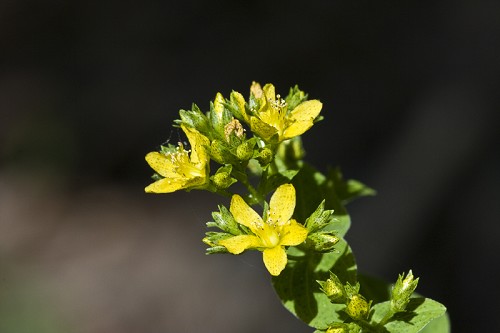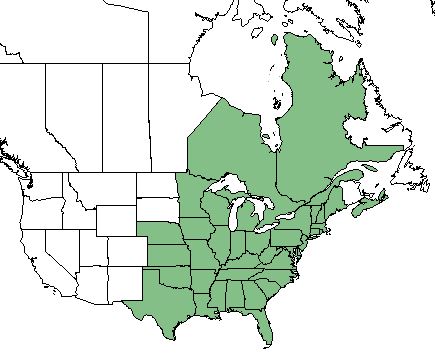Hypericum punctatum
spotted St. John's-wort[1]
| Hypericum punctatum | |
|---|---|

| |
| Photo by the Southeastern Flora Plant Database | |
| Scientific classification | |
| Kingdom: | Plantae |
| Division: | Magnoliophyta - Flowering plants |
| Class: | Magnoliopsida - Dicots |
| Order: | Theales |
| Family: | Clusiaceae |
| Genus: | Hypericum |
| Species: | H. punctatum |
| Binomial name | |
| Hypericum punctatum Lam. | |

| |
| Natural range of Hypericum punctatum from USDA NRCS Plants Database. | |
Contents
Taxonomic Notes
Synonyms: Hypericum punctatum var. punctatum[2]
Varieties: Hypericum punctatum Lamarck; Hypericum subpetiolatum E.P. Bicknell ex Small[2]
Description
H. punctatum is a perennial forb/herb of the Clusiaceae family native to North America.[1]
Distribution
H. punctatum is found throughout the eastern United States and up into Eastern Canada, specifically Ontario and Quebec.[1]
Ecology
Habitat
H. punctatum has a low drought tolerance and high shade tolerance.[1] It is commonly found in fields and woodland borders.[2] This species also has a low tolerance for calcium carbonate.[3] Specimens of H. punctatum have been collected from upland pinelands that are annually burned, and other similar sandhill habitats that are well-drained.[4] It has also been recorded in outcrop oak-hickory forests.[5]
Phenology
Flowers bloom between June and September.[1][6]
Seed dispersal
This species is thought to be dispersed by gravity.[7]
Fire ecology
H. punctatum is not a fire-resistant forb, but rather mildly tolerant.[1] A study in the Great Dismal Swamp in southeastern Virginia found this species present in areas that were commonly cut-burned.[8] Another study in dry sandstone barrens found this plant to increase by 75% in size, and increase 250% in occurrences after a fire disturbance.[9]
Pollination
This species is considered by pollination ecologists to be of special value to bumble bees since the flowers attract such large numbers.[3] More specifically, this species has been observed to host bees such as Bombus bimaculatus (family Apidae) and sweat bees such as Lasioglossum hitchensi (family Halictidae).[10]
Herbivory and toxicology
It has been recorded to be eaten by white-tailed deer.[11]
Conservation, cultivation, and restoration
It is considered vulnerable in the Canadian province Quebec, critically imperiled in Nebraska, and an exotic species in the Canadian province Newfoundland.[12]
Cultural use
Photo Gallery
References and notes
- ↑ 1.0 1.1 1.2 1.3 1.4 1.5 USDA Plant Database
- ↑ 2.0 2.1 2.2 Weakley, A.S. 2020. Flora of the Southeastern United States. Edition of 20 October 2020. University of North Carolina at Chapel Hill, Chapel Hill, North Carolina.
- ↑ 3.0 3.1 [[1]] Lady Bird Johnson Wildflower Center. Accessed: May 28, 2019
- ↑ Florida State University Robert K. Godfrey Herbarium database. URL: http://herbarium.bio.fsu.edu. Last accessed: May 2019. Collectors: Wilson Baker, Robert K. Godfrey, Jeffrey M. Kane, Roy Komarek, and R. A. Norris. States and Counties: Florida: Leon. Georgia: Thomas.
- ↑ Bostick, P. E. (1971). "Vascular Plants of Panola Mountian, Georgia " Castanea 46(3): 194-209.
- ↑ Cite error: Invalid
<ref>tag; no text was provided for refs namedWeakley - ↑ Kirkman, L. Katherine. Unpublished database of seed dispersal mode of plants found in Coastal Plain longleaf pine-grasslands of the Jones Ecological Research Center, Georgia.
- ↑ McKinley, C. E. and F. P. Day (1979). "Herbaceous production in cut-burned, uncut-burned and control areas of Chamaecyparis thyoides (L.) BSP (Cupressaceae) stand in the Great Dismal Swamp." Bulletin of the Torrey Botanical Club 106: 20-28.
- ↑ Taft, J. B. (2003). "Fire effects on community structure, composition, and diversity in a dry sandstone barrens." Journal of the Torrey Botanical Society 130: 170-192.
- ↑ Discoverlife.org [2]
- ↑ Atwood, E. L. (1941). "White-tailed deer foods of the United States." The Journal of Wildlife Management 5(3): 314-332.
- ↑ [[3]] NatureServe Explorer. Accessed: May 28, 2019